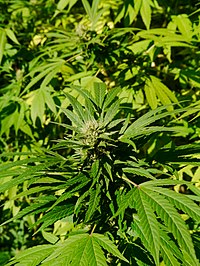
Photo from wikipedia
Cannabis sativa or hemp, defined as Click to show full abstract
Cannabis sativa or hemp, defined as <0.3% total tetrahydrocannabinol (THC), is a specialty crop in the United States, of particular interest among growers in the southeastern United States to replace tobacco production. Tetranychus urticae (twospotted spider mite), Aculops cannabicola (hemp russet mite), Polyphagotarsonemus latus (broad mites), and Phorodon cannabis (cannabis aphids) are considered the most significant pests in greenhouse grown hemp. Mite and aphid injury can cause cupping and yellowing of leaves, resulting in leaf drop, and reduced flower and resin production. We sought to understand the effects of feeding by T. urticae and Myzus persicae (green peach aphid), as a proxy for P. cannabis, on the concentration of economically significant cannabinoids through a series of experiments on greenhouse grown plants. First, we compared the variability of chemical concentrations in samples collected from individual plants versus pooled samples from 5 plants, and found that chemical concentrations in single plants were similar to those in pooled plant samples. Next, we compared chemical concentrations prior to arthropod infestation and post infestation. When evaluating the mite feeding damage in 2020, cannabinoids in plants infested with high densities of T. urticae increased more slowly than in uninfested control plants or plants infested with low T. urticae densities. In 2021, the concentration of tetrahydrocannabinol did not differ significantly between treatments. Cannabidiol increased more slowly in plants with low T. urticae densities when compared to uninfested controls but did not differ from the high T. urticae densities 14 days after infestation.
Journal Title: Environmental entomology
Year Published: 2023
Link to full text (if available)
Share on Social Media: Sign Up to like & get
recommendations!